Looking for Lampedusa – part 1
03 Feb 2016, by in BeginningsJacopo Colombini (TML Team)
Why did you choose this topic? Why is this important to you? These are some of the most recurrent and often underrated questions that can be asked of a researcher about to start her project.
In my opinion, the usual impact-driven focus of these questions, which are often followed up immediately by ‘how useful is this going to be?’ (here indeed is another tricky question!), should be diverted towards a more personal, almost intimate level. A researcher should ask herself: why devote many years of her life on one topic, subject, author or issue? Almost more than year ago I decided to analyze the progressive transnationalization of the name Lampedusa. So what is it that drives me in this particular project?
Answering this is not easy, it entails a self-reflective journey that needs to take into account the researcher’s personal interests, biography, class, race, gender, sexuality, education etc. In one single word, her own subjectivity. Discussing subjectivity is often complex: in addition to the researcher’s point of view there are different subjectivities to consider in one’s project, most importantly those of the participants. In choosing to adopt interviewing and participant observation as part of my research process, I also decided to embrace the centrality of my subjectivity in shaping all the different aspects of my work. Partially, I made this choice because I am far from convinced that ‘objective’ research is something that is possible, let alone a golden standard of social scientific research myself and others should be striving for.
Through this brief collection of images and comments, I will engage in a reflection on the reasons that have led me to focus on Lampedusa and its different representations. Undoubtedly, my personal understanding of Lampedusa is shaped by the representations offered by the media, the books I have read and I the persons I have met. Nevertheless, I am convinced that there is still some space to articulate a certain amount of agency in constructing my own imaginary of what Lampedusa is. Whit this brief text, I hope to offer some varied glimpses of how Lampedusa has come to be portrayed, seen, and understood from different perspectives, and how I have come to understand and interpret these seemingly diverse and fascinating representations and uses of ‘Lampedusa’ myself.
Therefore, why Lampedusa? What does Lampedusa mean to me? What did it mean to me when I started my PhD? What will it mean once I will be done with it?
I decided to ‘look for Lampedusa’ five years ago. Three years before starting this project. Where was Lampedusa for me at that time?
The answer seemed quite easy: a tiny Sicilian island, the southernmost spot of Italy, ‘La porta d’Europa’. It was 2011, and the ‘border spectacle’ (Cuttitta, 2012) was at its peak. The recurring, highly dramatic images of the events taking place on the island, intertwined with humanitarian and securitarian arguments supported an image of emergency. Later, I would spend time reflecting on how to deconstruct this apparently unchanging and hegemonic representation of Lampedusa, but at the time I was more concerned with what was happening on the island. My first contact with what was going on Lampedusa were the words of Fabrizio Gatti:
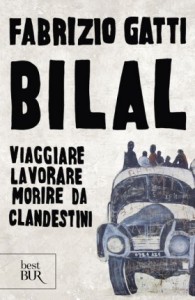
‘[…] «Perché vuoi sapere cosa succede a Lampedusa?» chiede Abdel. […] Sei mai stato a Milano?» «Si» risponde lui con lo sguardo un po’ sorpreso. «Il Comune di Milano ha chiuso il suo zoo perché i cittadini sensibili e indignati non potevano più vedere scimmie, leoni e giraffe prigionieri in gabbia. Era il 1992, ricordati questa data.» Abdel annuisce sempre più stupito. «Nel 1999, appena sette anni dopo, l’Italia e i milanesi hanno invece costruito una grande gabbia e ci hanno messo dentro uomini e donne. E nessuno dei milanesi, degli italiani sembrava più indignarsi. Adesso gabbie come quella ce ne sono in tutta Italia. E la gabbia di Lampedusa è diventata una macchina infernale. L’ingranaggio centrale delle deportazioni di massa messe in atto dall’Italia con la complicità della Germania e dell’Unione Europea. La più grande deportazione che coinvolge l’Europa dalla fine della Seconda guerra mondiale. Il tradimento degli ideali di libertà, uguaglianza e fraternità. […] Te lo dico senza mezzi termini. La gabbia di Lampedusa oggi è diventata la vergogna della nostra democrazia. La più grande menzogna dell’Europa unita che stiamo costruendo. Ecco perché mi interessa sapere cosa succede là dentro’.
Gatti F., 2007, Bilal. Viaggiare, lavorare, morire da clandestini, Milano, Bur-Rizzoli, pp. 298-299.
The work of Gatti, but also Gabriele Del Grande’s books ‘Mamadou va a morire’ (2007) and ‘Il mare di mezzo’ (2010), not only played an important role in shaping my personal relationship with the topic, but they also played a significant part in the construction of the hegemonic representation of Lampedusa in the public sphere. Heidrun Friese, carrying one of the first ethnographic accounts on the island since the start of the so-called ‘emergenza’, also noted the impact of this progressive ‘mediatization’ in shaping the perception of the events taking place on the island:
“[…] it is not surprising that the first question a stranger is being asked is: ‘Are you a journalist?’ (That is to say – do you want to make trouble?) Media coverage had additional consequences. One does not rely on one’s own experience and understanding any more; that which is real, is that which has been published and shown in TV. Therefore, one repeats was has already been said and transformed into public images and views […] (p. 11, 2008)”.
What was the next step then? Developing my research questions and planning a journey to Lampedusa? Not yet.
Indeed, the idea of having been on the island is sometimes very appealing, especially if – every time I explain the topic of my research to someone – half of my interlocutors ask me whether I have been there or not.
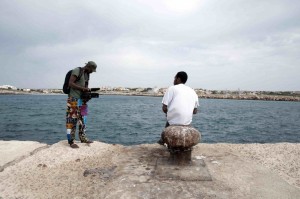
Filming of “To whom it may concern”. Source: Archivio Memorie Migranti. Photo: Mario Badagliacca.
To me, it seems that the idea of going to Lampedusa – being there and literally touching it – appears to many as the only way of experiencing it. Unsurprisingly, this ‘quest for authenticity’ has added the category of researchers to this ‘interdependency of seemingly unrelated mobilities’ (Bayraktar, 2012) composed by migrants, tourists, journalists, border guards, activists etc. that populates the island. It is important to keep in mind that researchers and journalists (and the so-called ‘migration industry’), enjoy a high amount of mobility whereas often the ‘subjects’ of their work do not have such privilege. Stories are often ‘taken away’, but little is left behind. Of course, this is not a categorical refusal to visit the island, and I am sure that this will eventually happen, but in my work I opted for a longer journey, a journey through the words and images of Zakaria Mohamed Ali and Dagmawi Yimer, the locations of ‘Lampedusa in Hamburg’, the streets of Berlin and the pavilions of Venice’s biennale.
Lampedusa has been defined in various ways: as an artificially constructed border ‘spectacularized’ by ‘securitarian’ and ‘humanitarian’ political discourses (Cuttitta, 2012), as a ‘spectacle of bare life’ (Dines et al., 2014) and as a ‘crisis heterotopia’ (Pugliese, 2009). A place that can combine at the same time “violently contradictory differences”, an island where “overlapping racialogical histories of whiteness, colonialism and empire, and attendant anxieties about securing a nation’s borders” (Pugliese, 2009, p. 664) coexist with the amenities of a ‘dream’ holiday location.
But Lampedusa can also be found far from the Mediterranean Sea. During the last years, for instance, I have found Lampedusa on a summer’s evening in Kreuzberg, Berlin, in the images of ‘To whom it may concern’ and in the discussion shared with the members of the Archivio Memorie Migranti.
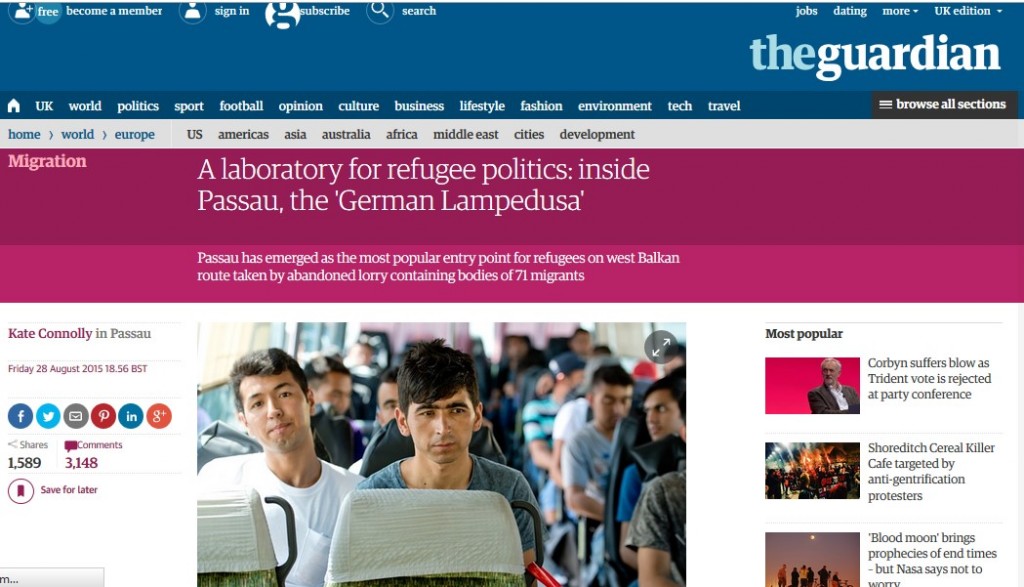
The Guardian 28 August 2015.
Through the few pictures presented here, I will attempt to show how Lampedusa has travelled and has become a symbol, not only a keyword associated with the so-called ‘refugee crises’ to recall humanitarian and securitarian discourses, but also how in different contexts it has become a symbol of a collective identity and resistance. Perhaps, my personal understanding of Lampedusa will shine through during this journey, by showing how different ‘regimes’ of representation are shaped by their specific social, political, and historical context. “The production of Lampedusa’s sense of place changes according to the shifting geopolitical configuration” (Bayraktar, 2012, p. 20), for instance before and after the ‘Arab Spring’, but also according to the locations and, most importantly, according to the individual experiences and readings of the persons that feel somehow connected to it.
Photos 1,2,3,4
Oranienplatz, Berlin, July 2015
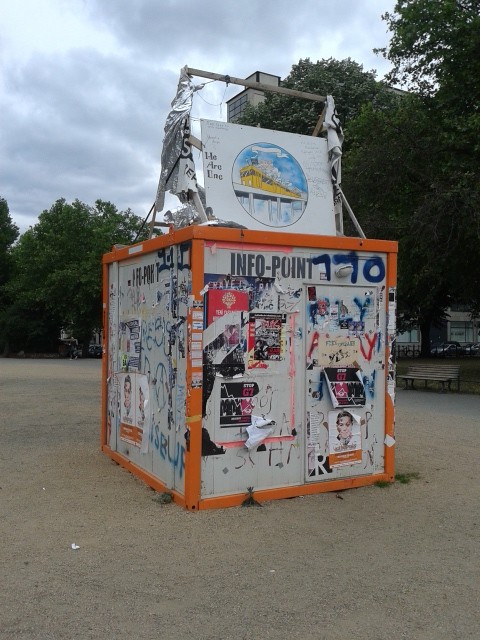
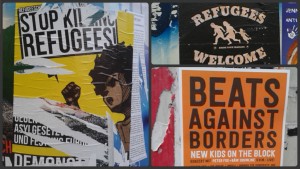 During a brief summer visit to Berlin, I have a few days to explore the city. Soon after arriving, I decide to visit Oranienplatz. This square, located in Kreuzberg, can be considered one of the symbols for the political struggle for refugees’ rights in Germany over the last three years. In October 2012, groups of refugees coming from all over Germany gathered in the square, creating the premises for one of the most important self-organised campaigns for refugees’ rights in recent German history. The tents occupying Oranienplatz successfully gave visibility to the groups’ claims, pushing the local government to undertake negotiations over the demands of the occupants. In March 2013, a group referring to themselves as ‘Lampedusa in Berlin’ joined the movement. The group seemed to mirror the events taking place in Hamburg, where a large group of refugees fleeing the war in Libya (in possess of papers issued by the Italian government), established the group ‘Lampedusa in Hamburg’ to claim working permits in Germany.
During a brief summer visit to Berlin, I have a few days to explore the city. Soon after arriving, I decide to visit Oranienplatz. This square, located in Kreuzberg, can be considered one of the symbols for the political struggle for refugees’ rights in Germany over the last three years. In October 2012, groups of refugees coming from all over Germany gathered in the square, creating the premises for one of the most important self-organised campaigns for refugees’ rights in recent German history. The tents occupying Oranienplatz successfully gave visibility to the groups’ claims, pushing the local government to undertake negotiations over the demands of the occupants. In March 2013, a group referring to themselves as ‘Lampedusa in Berlin’ joined the movement. The group seemed to mirror the events taking place in Hamburg, where a large group of refugees fleeing the war in Libya (in possess of papers issued by the Italian government), established the group ‘Lampedusa in Hamburg’ to claim working permits in Germany.
After the failure of the negotiations with the Berlin government, the occupants were finally evicted in April 2014. At the time of my visit, the ‘info-point’ stands as the last remains of almost 3 years of struggle on this square.
Despite the failure of the negotiations, I am amazed by the high level of commitment towards refugees’ and migrants’ rights in the city. In just a few days, I have the chance to take part in two big demonstrations related to this topic.
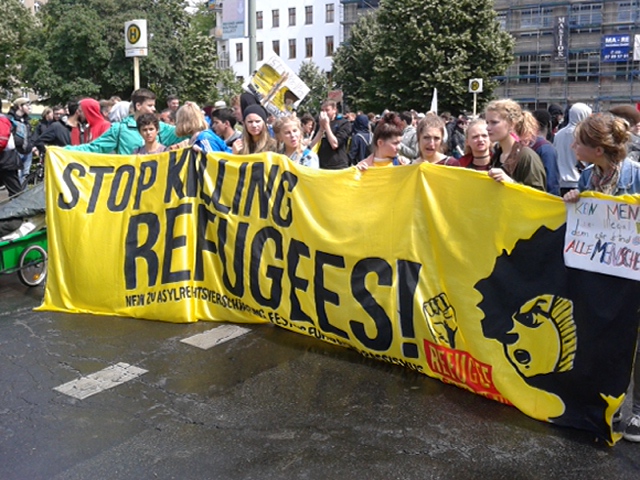

Photo 5
Kreuzberg, Berlin, July 2015 
Based on a chapter of a book of Navid Kermani (2013), local actors stage a small play about the events taking place in Italy. The audience is invited to sit and be part of the setting. Wine, pizza and bruschetta are offered to us. After a short video by Watch the Med reporting a left-to-die boat case of some years ago, we listen to the speech of the ‘mayor of Lampedusa’. A whispered translation in English allows me to follow the grotesque impression of the mayor. The words of this stereotyped cliché of an Italian man sum up perfectly the destiny of an the island “caught between shipwreck and tourism” (Arnone, 2015).
Photos 6,7,8,9,10
Platz der Republik, Berlin, July 21st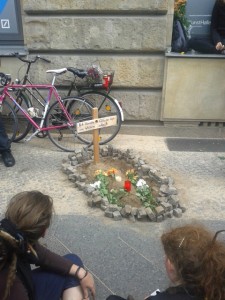
‘Die Toten Kommen’. The ‘Zentrum für Politische Schönheit’ (the Center for Political Beauty) – already known for an intervention that sought to politically re-signify the white crosses in memory of the victims of the Berlin Wall by bringing them to Melilla, and publishing photos with the ‘future dead of the wall’ there – stages another powerful performance. The action aims to bring the invisible victims of the European border regime directly in front of eyes of the German government and citizens. From an anonymous grave in Sicily to the German Reichstag, a masterwork in retaining visibility for the struggle against the border regime, and for the many dead it keeps causing at the EU’s external borders.
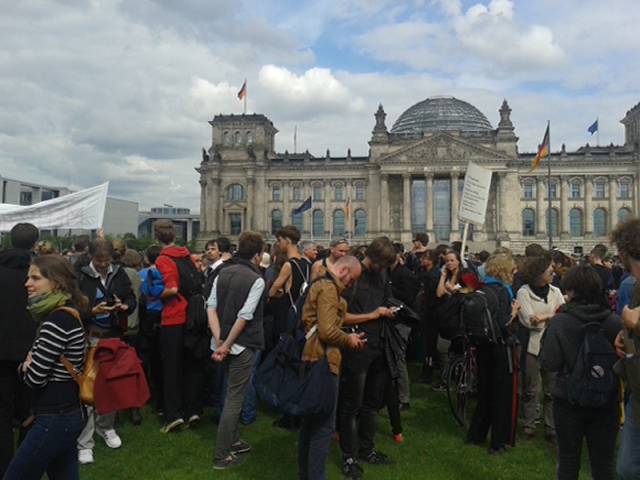
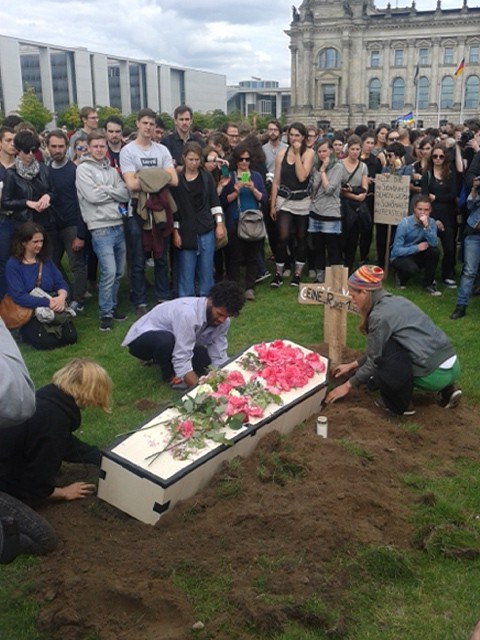
The demonstration has a large following, and soon after small symbolic tombstones and crosses appear all around Germany.
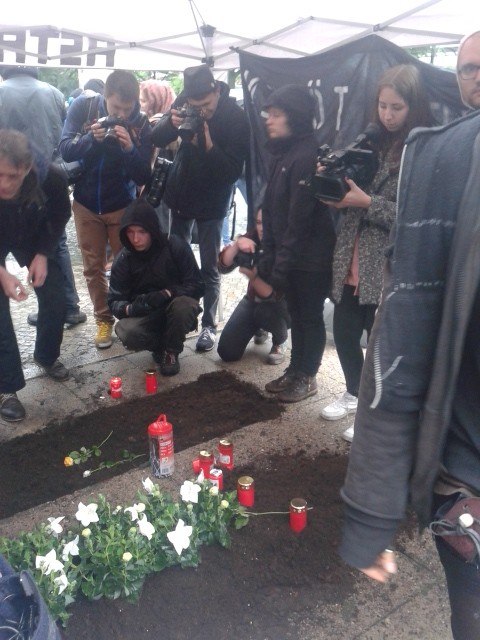
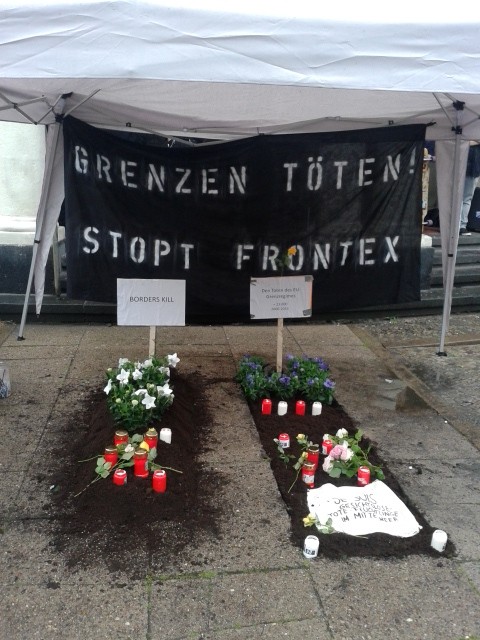
Edmund Siemers Allee, Hamburg Uni, Hamburg, July 21-22
Photo 11,12, 13, 14, 15, 16
St. Pauli, Hamburg, July 2015
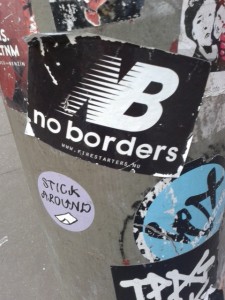
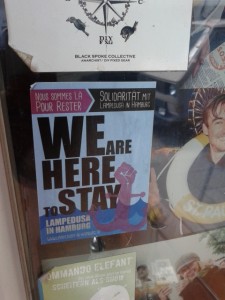
‘Lampedusa in Hamburg’.
A lot of things have changed since my last visit in Hamburg. After March 2013, the moment when ‘Lampedusa’ arrived in Hamburg, I look at the major sights differently. I walk along the streets of St. Pauli looking for traces of the presence of the group. My local contacts confirm that I have come in a difficult moment: after two years of intense campaigning, the summer is a moment for reflection and reorganization.
The last official statement from the website of the Lampedusa in Hamburg group dates back to February 2015: 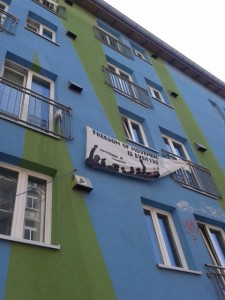
“Here in Hamburg we have fought nearly two years for our right to finally rebuild our life. We are not allowed to work, in order to survive we depend on the solidarity of Hamburg’s citizens. Many still live on the streets, over 100 have are provisionally accommodated by supporters. The “Duldung” that was offered to us by the authorities is no improvement of our situation. A “Duldung” is just a temporary suspension of a deportation, nothing more. […]”
“[…] We just want the right to stay and work here in Hamburg so that we can sustain ourselves and our families. We demand the europe-wide recognition of our Italian residence and working permits. Is Italy not a member of the European Union? Or don’t the European rights apply for everyone?”
Lampedusa in Hamburg, February 2015
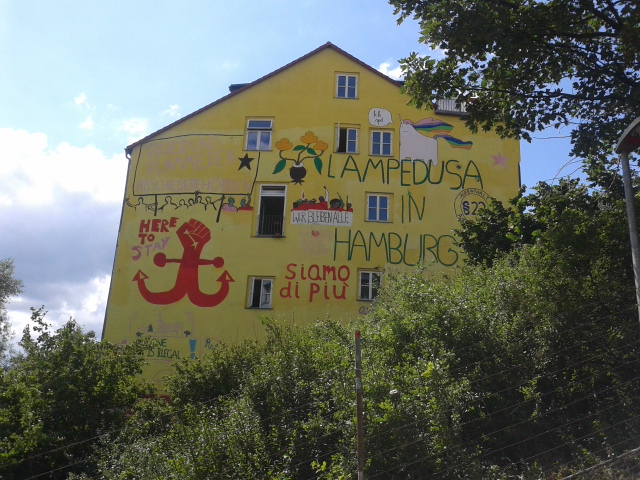
Hafenstraße and Bernhard-Nocht-Straße, Hamburg, July 2015.
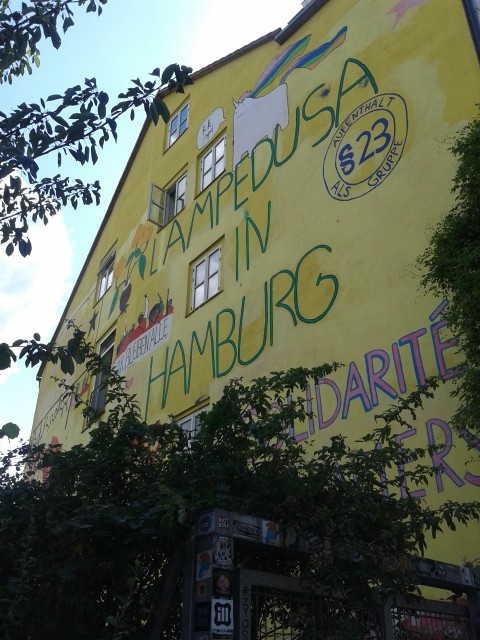 The housing projects and cooperatives of the Hafenstraße, also known for their past and present political commitment in leftist and autonomous scene of Hamburg, offered support and accommodation for many of the members of Lampedusa in Hamburg.
The housing projects and cooperatives of the Hafenstraße, also known for their past and present political commitment in leftist and autonomous scene of Hamburg, offered support and accommodation for many of the members of Lampedusa in Hamburg. 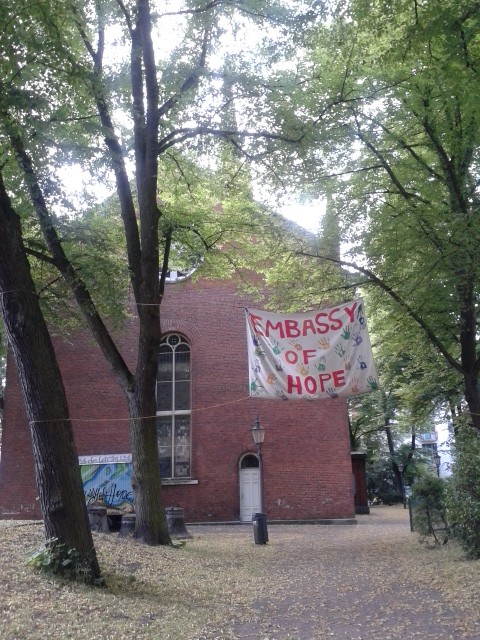 Around 80 other members of the group found support and shelter in the St. Pauli Kirche. Different initiatives were taken within the church. Among the most notable, Nobel prize winner Elfriede Jelinek staged her ‘Die Schutzbefohlenen’ in the church.
Around 80 other members of the group found support and shelter in the St. Pauli Kirche. Different initiatives were taken within the church. Among the most notable, Nobel prize winner Elfriede Jelinek staged her ‘Die Schutzbefohlenen’ in the church.
Photo 17
FHXB Museum, Kreuzberg, Berlin, August 2015
In August, I return to Berlin to visit the exhibition ‘We Will Rise’. Despite the eviction, the experience of Oranienplatz still lives in the materials collected in the museum. The panels are scattered along the stairs of the museum in chronological order. The pictures, the banners, the flyers are a clear attempt for the ‘historicization’ or ‘memoralization’ of these very recent events.
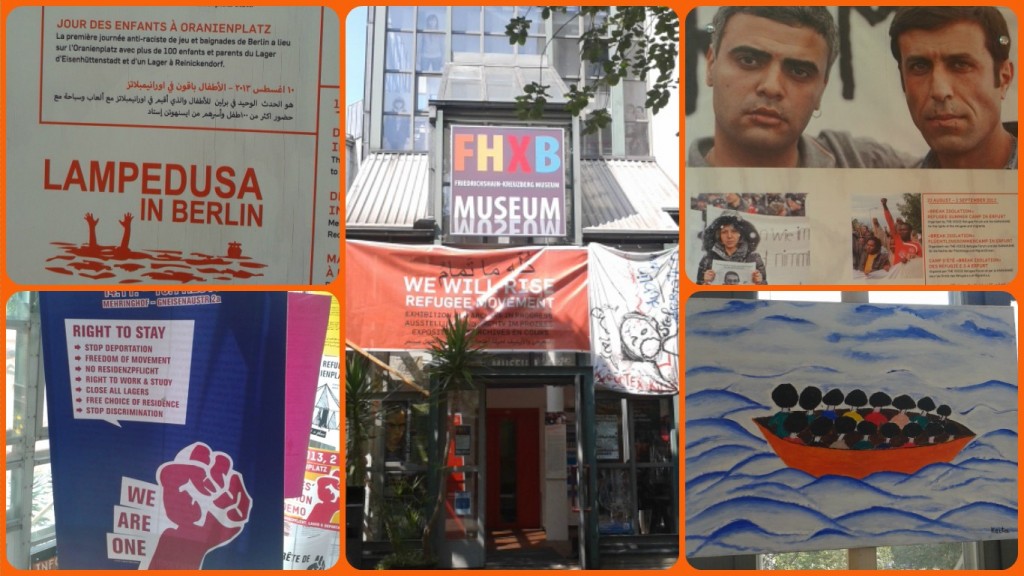
A theme, that of the ‘archive’ and of the ‘museum of migration’, appears to be recurrent in my contacts with the name Lampedusa. The Archivio Memorie Migranti, Porto M and Ort_M are other examples of this important process. The selection, construction, and questioning of the memories of the current migratory phenomenon will be an important part of my research.
Photo 18, 19, 20
Biennale, Venezia, September 2015
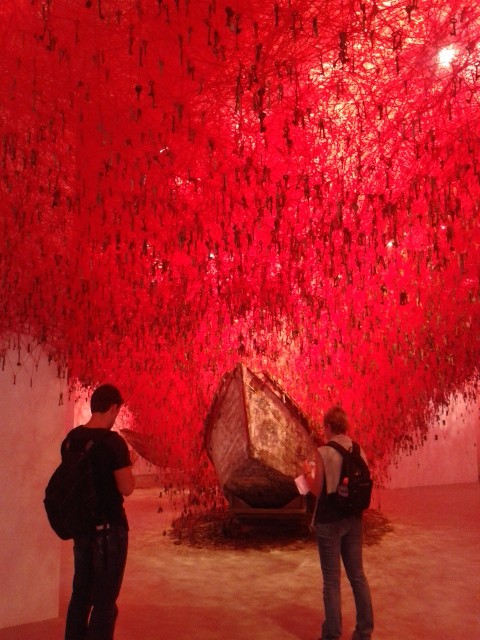 The first part of my journey ends in Venice. Thanks to the TML Summer School in Transnational Italian Studies, I have the opportunity to visit the pavilions of the Biennale. The theme of memory is recurrent within the pavilions and Chiharu Shiota’s “The Key in the Hand” (photo on the left) represents it in a way that leaves a lasting impression on me.
The first part of my journey ends in Venice. Thanks to the TML Summer School in Transnational Italian Studies, I have the opportunity to visit the pavilions of the Biennale. The theme of memory is recurrent within the pavilions and Chiharu Shiota’s “The Key in the Hand” (photo on the left) represents it in a way that leaves a lasting impression on me.
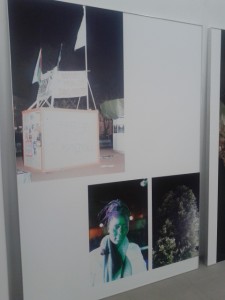
To my surprise I realize that Lampedusa, particularly Lampedusa in Hamburg and in Berlin, are also here.
Jacopo Colombini, Hamburg, January 2016
Photo Gallery
References
Bayraktar, N., 2012. Heterotopic intersections of tourism and undocumented migration in Southern Europe: The video essay Sudeuropa (2005–2007). New Cine. J. Contemp. Film 10, 17–43.
Cuttitta, P., 2012. Lo spettacolo del confine: Lampedusa tra produzione e messa in scena della frontiera, Milano, Mimesis.
Del Grande G., 2007. Mamadou va a morire La strage dei clandestini nel Mediterraneo, Castel Gandolfo (Roma), Infinito.
Del Grande G., 2009. Il Mare di mezzo al tempo dei respingimenti, Castel Gandolfo (Roma), Infinito.
Dines, N., Montagna, N., Ruggiero, V., 2015. Thinking Lampedusa: border construction, the spectacle of bare life and the productivity of migrants. Ethn. Racial Stud. 38, 430–445.
Friese H., 2008. The Limits of Hospitality. Lampedusa, Local Perspectives and Undocumented Migration, Paper presented at the Migration Working Group, EUI, Florence, 13.2.2008.
Gatti F., 2007. Bilal. Viaggiare, lavorare, morire da clandestini, Milano, Bur-Rizzoli.
Kermani N., 2013. Ausnahmezustand. Reisen in eine beunruhigte Welt. München, C. H. Beck.
Pugliese, J., 2009. Crisis heterotopias and border zones of the dead. Continuum 23, 663–679.



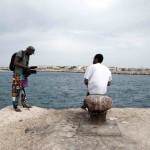
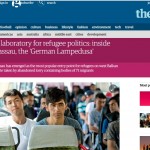
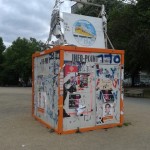
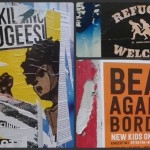
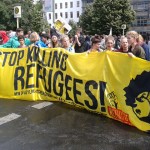

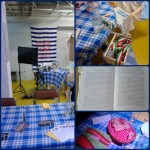
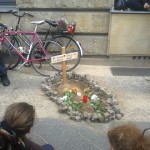
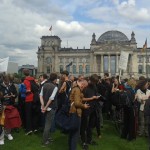
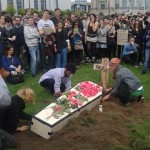
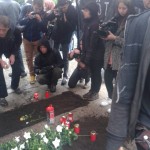
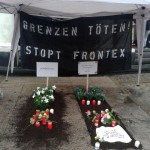
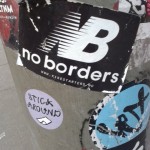
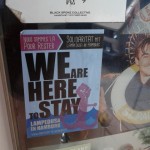
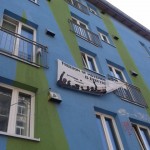
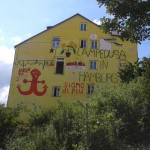
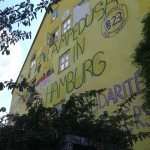
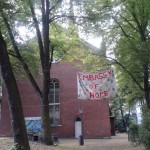
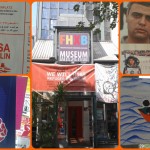
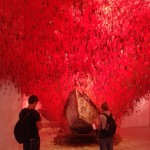
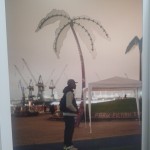
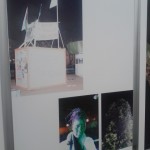
Sorry, the comment form is closed at this time.